2018 KIA K900 towing
[x] Cancel search: towingPage 404 of 544
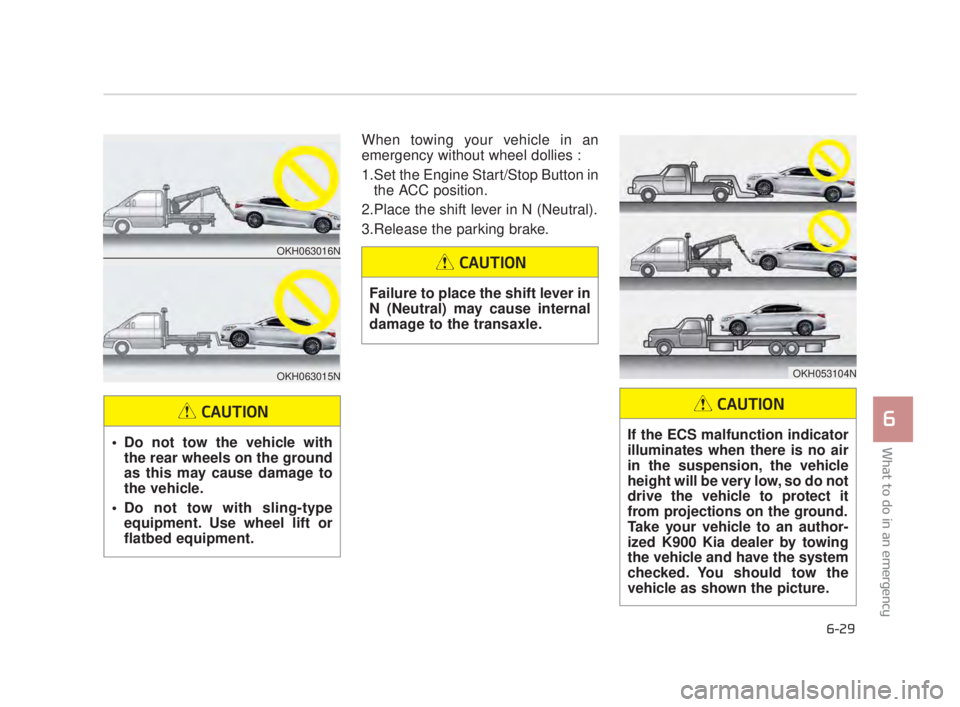
What to do in an emergency
6
6-29
When towing your vehicle in an
emergency without wheel dollies :
1.Set the Engine Start/Stop Button inthe ACC position.
2.Place the shift lever in N (Neutral).
3.Release the parking brake.
OKH063016N
OKH063015N
Do not tow the vehicle with the rear wheels on the ground
as this may cause damage to
the vehicle.
Do not tow with sling-type equipment. Use wheel lift or
flatbed equipment.
CAUTION
OKH053104N
Failure to place the shift lever in
N (Neutral) may cause internal
damage to the transaxle.
CAUTION
If the ECS malfunction indicator
illuminates when there is no air
in the suspension, the vehicle
height will be very low, so do not
drive the vehicle to protect it
from projections on the ground.
Take your vehicle to an author-
ized K900 Kia dealer by towing
the vehicle and have the system
checked. You should tow the
vehicle as shown the picture.
CAUTION
KH USA 6:2018 4/12/2017 10:22 AM Page 29
Page 405 of 544
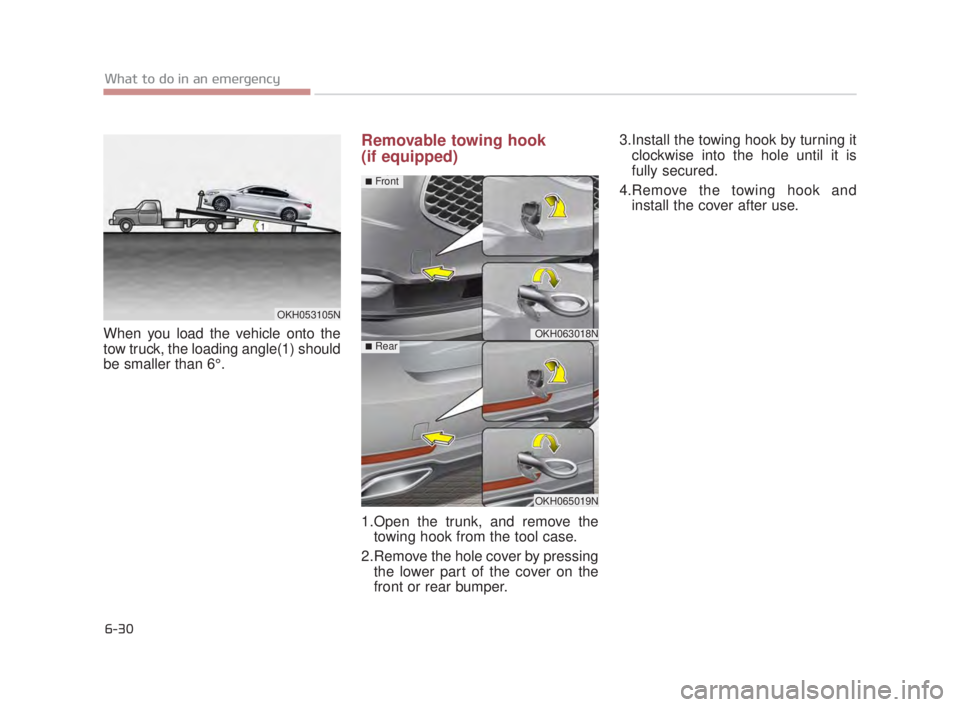
6-30
What to do in an emergency
When you load the vehicle onto the
tow truck, the loading angle(1) should
be smaller than 6°.
Removable towing hook
(if equipped)
1.Open the trunk, and remove thetowing hook from the tool case.
2.Remove the hole cover by pressing the lower part of the cover on the
front or rear bumper. 3.Install the towing hook by turning it
clockwise into the hole until it is
fully secured.
4.Remove the towing hook and install the cover after use.
OKH053105N
OKH063018N
OKH065019N
■Front
■Rear
KH USA 6:2018 4/12/2017 10:22 AM Page 30
Page 406 of 544
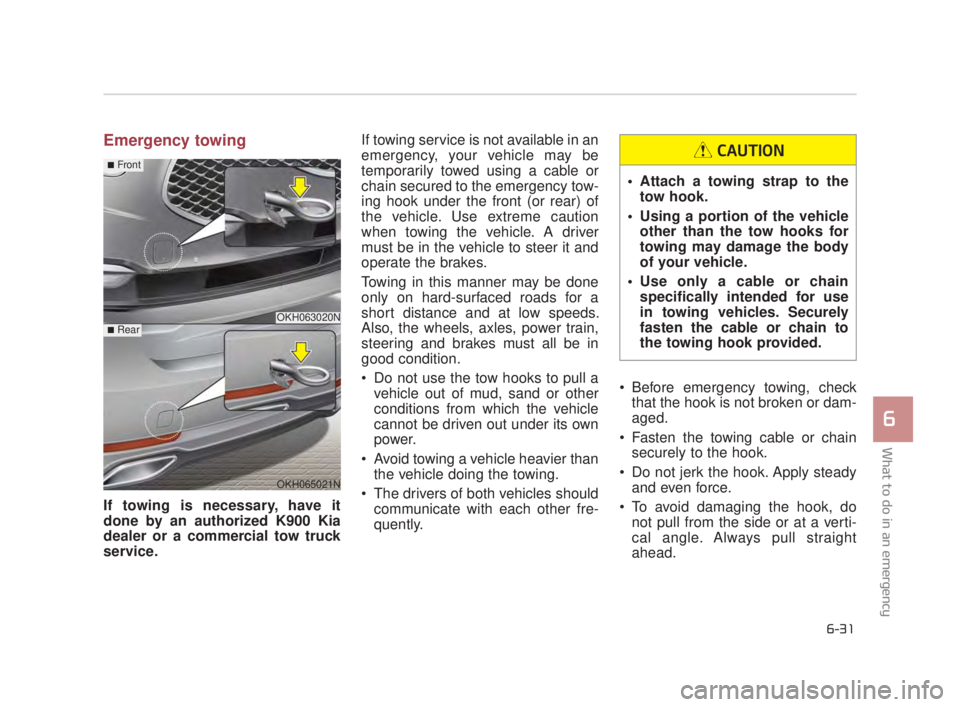
What to do in an emergency
6
6-31
Emergency towing
If towing is necessary, have it
done by an authorized K900 Kia
dealer or a commercial tow truck
service. If towing service is not available in an
emergency, your vehicle may be
temporarily towed using a cable or
chain secured to the emergency tow-
ing hook under the front (or rear) of
the vehicle. Use extreme caution
when towing the vehicle. A driver
must be in the vehicle to steer it and
operate the brakes.
Towing in this manner may be done
only on hard-surfaced roads for a
short distance and at low speeds.
Also, the wheels, axles, power train,
steering and brakes must all be in
good condition.
Do not use the tow hooks to pull a
vehicle out of mud, sand or other
conditions from which the vehicle
cannot be driven out under its own
power.
Avoid towing a vehicle heavier than the vehicle doing the towing.
The drivers of both vehicles should communicate with each other fre-
quently. Before emergency towing, check
that the hook is not broken or dam-
aged.
Fasten the towing cable or chain securely to the hook.
Do not jerk the hook. Apply steady and even force.
To avoid damaging the hook, do not pull from the side or at a verti-
cal angle. Always pull straight
ahead.
OKH063020N
OKH065021N
■Front
■Rear
Attach a towing strap to thetow hook.
Using a portion of the vehicle other than the tow hooks for
towing may damage the body
of your vehicle.
Use only a cable or chain specifically intended for use
in towing vehicles. Securely
fasten the cable or chain to
the towing hook provided.
CAUTION
KH USA 6:2018 4/12/2017 10:22 AM Page 31
Page 407 of 544
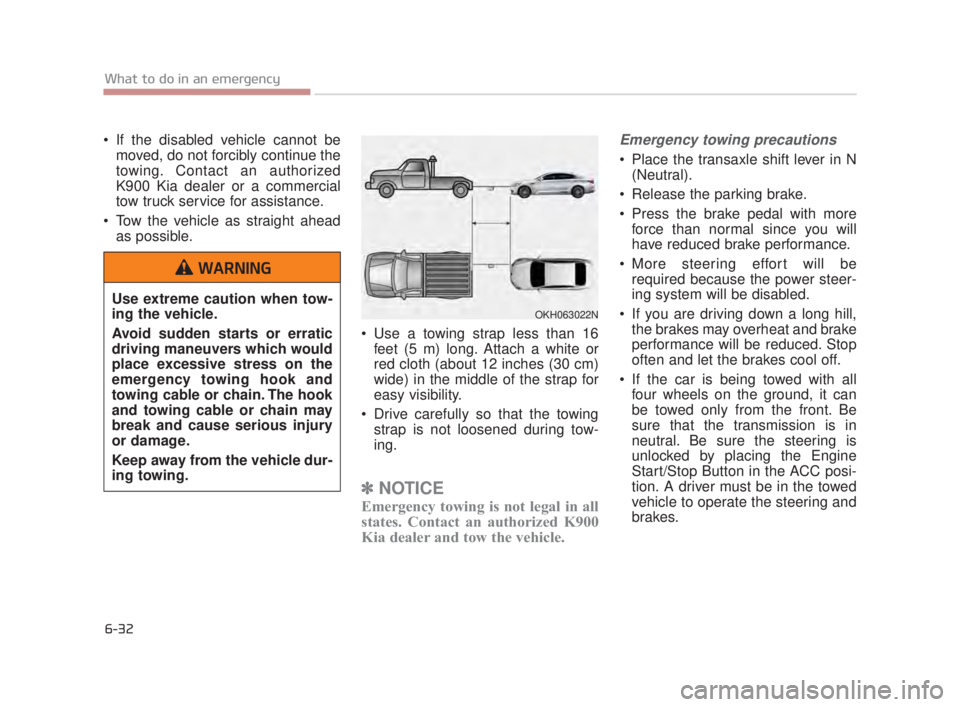
6-32
What to do in an emergency
If the disabled vehicle cannot bemoved, do not forcibly continue the
towing. Contact an authorized
K900 Kia dealer or a commercial
tow truck service for assistance.
Tow the vehicle as straight ahead as possible.
Use a towing strap less than 16feet (5 m) long. Attach a white or
red cloth (about 12 inches (30 cm)
wide) in the middle of the strap for
easy visibility.
Drive carefully so that the towing strap is not loosened during tow-
ing.
✽ NOTICE
Emergency towing is not legal in all
states. Contact an authorized K900
Kia dealer and tow the vehicle.
Emergency towing precautions
Place the transaxle shift lever in N
(Neutral).
Release the parking brake.
Press the brake pedal with more force than normal since you will
have reduced brake performance.
More steering effort will be required because the power steer-
ing system will be disabled.
If you are driving down a long hill, the brakes may overheat and brake
performance will be reduced. Stop
often and let the brakes cool off.
If the car is being towed with all four wheels on the ground, it can
be towed only from the front. Be
sure that the transmission is in
neutral. Be sure the steering is
unlocked by placing the Engine
Start/Stop Button in the ACC posi-
tion. A driver must be in the towed
vehicle to operate the steering and
brakes.
Use extreme caution when tow-
ing the vehicle.
Avoid sudden starts or erratic
driving maneuvers which would
place excessive stress on the
emergency towing hook and
towing cable or chain. The hook
and towing cable or chain may
break and cause serious injury
or damage.
Keep away from the vehicle dur-
ing towing.
WARNING
OKH063022N
KH USA 6:2018 4/12/2017 10:22 AM Page 32
Page 408 of 544
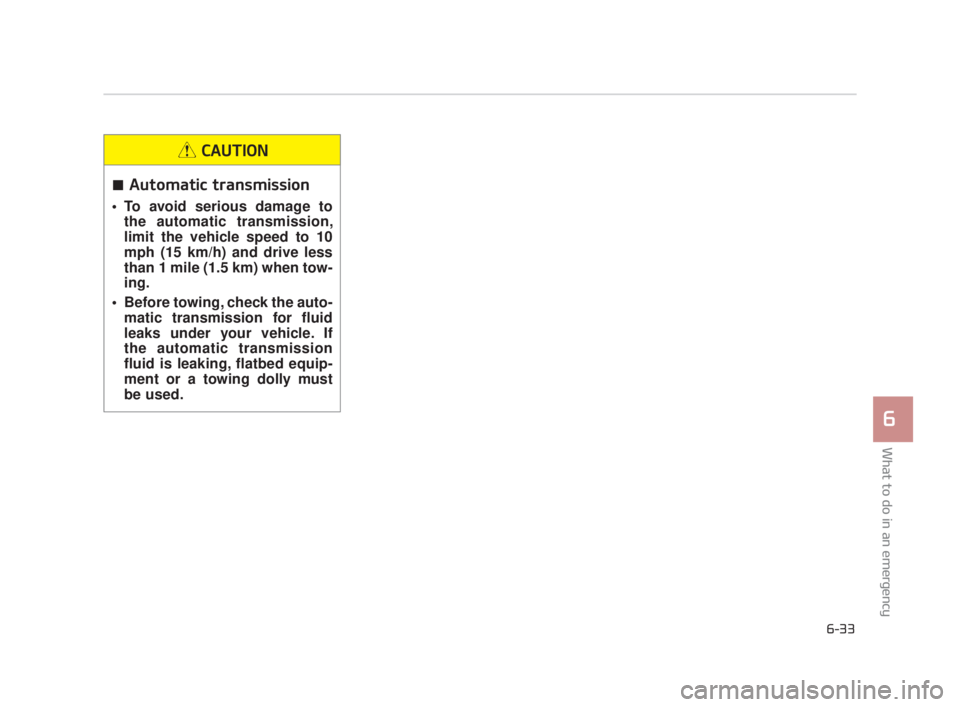
What to do in an emergency
6
6-33
Automatic transmission
To avoid serious damage tothe automatic transmission,
limit the vehicle speed to 10
mph (15 km/h) and drive less
than 1 mile (1.5 km) when tow-
ing.
Before towing, check the auto- matic transmission for fluid
leaks under your vehicle. If
the automatic transmission
fluid is leaking, flatbed equip-
ment or a towing dolly must
be used.
CAUTION
KH USA 6:2018 4/12/2017 10:22 AM Page 33
Page 418 of 544

7-10
Maintenance
SCHEDULED MAINTENANCE SERVICE
Follow Normal Maintenance Schedule
if the vehicle is usually operated where
none of the following conditions apply.
If any of the following conditions apply,
follow Maintenance Under Severe
Usage Conditions.
Repeated driving short distance ofless than 5 miles (8 km) in normal
temperature or less than 10 miles
(16 km)in freezing temperature
Extensive engine idling or low speed driving for long distances
Driving on rough, dusty, muddy, unpaved, graveled or salt-spread
roads
Driving in areas using salt or other corrosive materials or in very cold
weather
Driving in heavy dust condition
Driving in heavy traffic area
Driving on uphill, downhill, or mountain road repeatedly
Towing a trailer or using a camper, or roof rack
Driving as a patrol car, taxi, other commercial use of vehicle towing
Driving over 106 mile/h(170 km/h) Frequently driving in stop-and-go
condition
If your vehicle is operated under theabove conditions, you should inspect,replace or refill more frequently thanthe following Normal MaintenanceSchedule. After 120 months or150,000 miles (240,000 km) continueto follow the prescribed maintenanceintervals.
KH USA 7:2018 4/14/2017 6:37 PM Page 10
Page 436 of 544
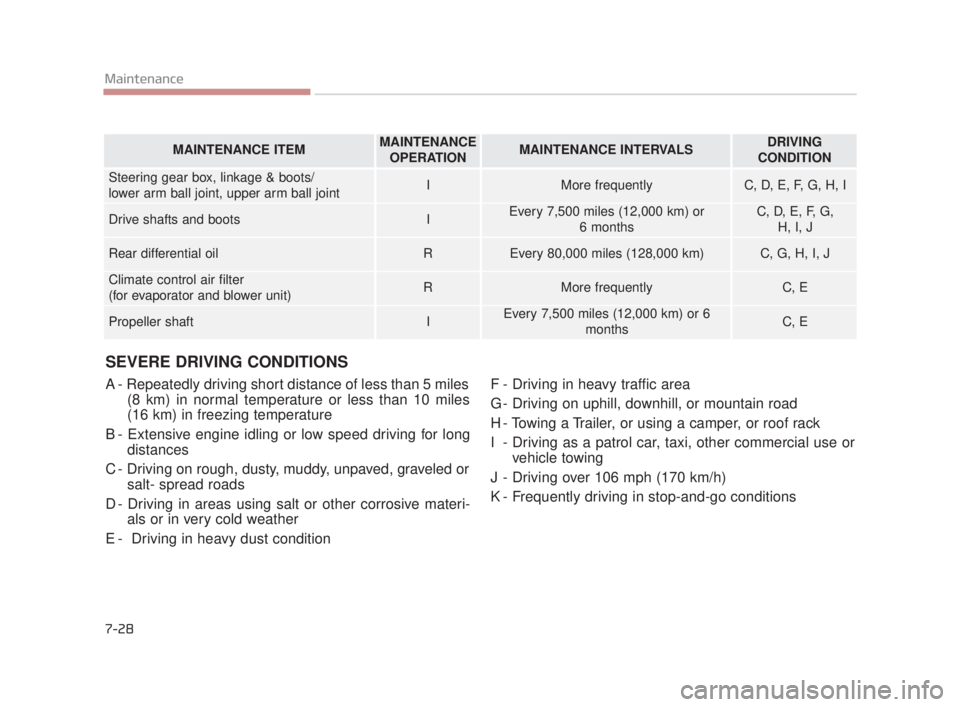
7-28
Maintenance
SEVERE DRIVING CONDITIONS
A - Repeatedly driving short distance of less than 5 miles(8 km) in normal temperature or less than 10 miles
(16 km) in freezing temperature
B - Extensive engine idling or low speed driving for long distances
C - Driving on rough, dusty, muddy, unpaved, graveled or salt- spread roads
D - Driving in areas using salt or other corrosive materi- als or in very cold weather
E - Driving in heavy dust condition F - Driving in heavy traffic area
G - Driving on uphill, downhill, or mountain road
H - Towing a Trailer, or using a camper, or roof rack
I - Driving as a patrol car, taxi, other commercial use or
vehicle towing
J - Driving over 106 mph (170 km/h)
K - Frequently driving in stop-and-go conditions
MAINTENANCE ITEMMAINTENANCE OPERATIONMAINTENANCE INTERVALSDRIVING
CONDITION
Steering gear box, linkage & boots/
lower arm ball joint, upper arm ball jointIMore frequentlyC, D, E, F, G, H, I
Drive shafts and bootsIEvery 7,500 miles (12,000 km) or 6 monthsC, D, E, F, G, H, I, J
Rear differential oilREvery 80,000 miles (128,000 km)C, G, H, I, J
Climate control air filter
(for evaporator and blower unit)RMore frequentlyC, E
Propeller shaftIEvery 7,500 miles (12,000 km) or 6 monthsC, E
KH USA 7:2018 4/14/2017 6:37 PM Page 28
Page 542 of 544
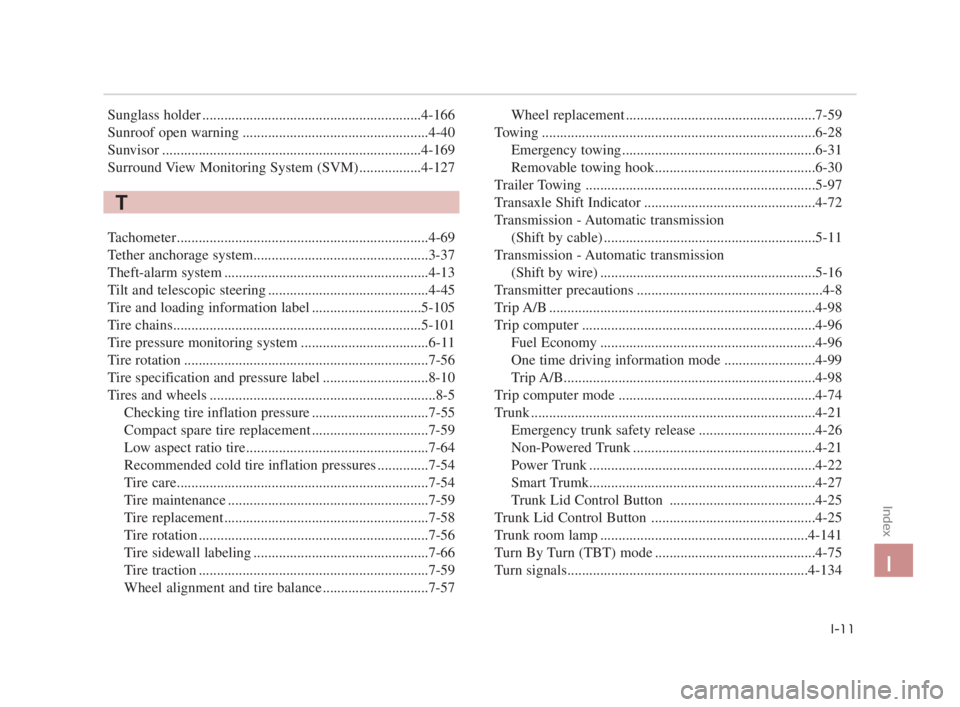
Sunglass holder ............................................................4-166
Sunroof open warning ...................................................4-40
Sunvisor .......................................................................4\
-169
Surround View Monitoring System (SVM).................4-127
Tachometer.....................................................................4-6\
9
Tether anchorage system................................................3-\
37
Theft-alarm system ........................................................4-13
Tilt and telescopic steering ............................................4-45
Tire and loading information label ..............................5-105
Tire chains....................................................................5-10\
1
Tire pressure monitoring system ...................................6-11
Tire rotation ...................................................................7-56
Tire specification and pressure label .............................8-10
Tires and wheels ..............................................................8-5Checking tire inflation pressure ................................7-55
Compact spare tire replacement ................................7-59
Low aspect ratio tire..................................................7-64
Recommended cold tire inflation pressures ..............7-54
Tire care.....................................................................7-5\
4
Tire maintenance .......................................................7-59
Tire replacement ........................................................7-58
Tire rotation ...............................................................7-56
Tire sidewall labeling ................................................7-66
Tire traction ...............................................................7-59
Wheel alignment and tire balance .............................7-57 Wheel replacement ....................................................7-59
Towing ........................................................................\
...6-28 Emergency towing.....................................................6-31
Removable towing hook............................................6-30
Trailer Towing ...............................................................5-97
Transaxle Shift Indicator ...............................................4-72
Transmission - Automatic transmission (Shift by cable) ..........................................................5-11
Transmission - Automatic transmission (Shift by wire) ...........................................................5-16
Transmitter precautions ...................................................4-8
Trip A/B ........................................................................\
.4-98
Trip computer ................................................................4-96 Fuel Economy ...........................................................4-96
One time driving information mode .........................4-99
Trip A/B.....................................................................4-9\
8
Trip computer mode ......................................................4-74
Trunk ........................................................................\
......4-21 Emergency trunk safety release ................................4-26
Non-Powered Trunk ..................................................4-21
Power Trunk ..............................................................4-22
Smart Trumk..............................................................4-27
Trunk Lid Control Button ........................................4-25
Trunk Lid Control Button .............................................4-25
Trunk room lamp .........................................................4-141
Turn By Turn (TBT) mode ............................................4-75
Turn signals..................................................................4-134
Index
I-11
I
T
KH USA Index:2018 4/18/2017 10:39 AM Page 11